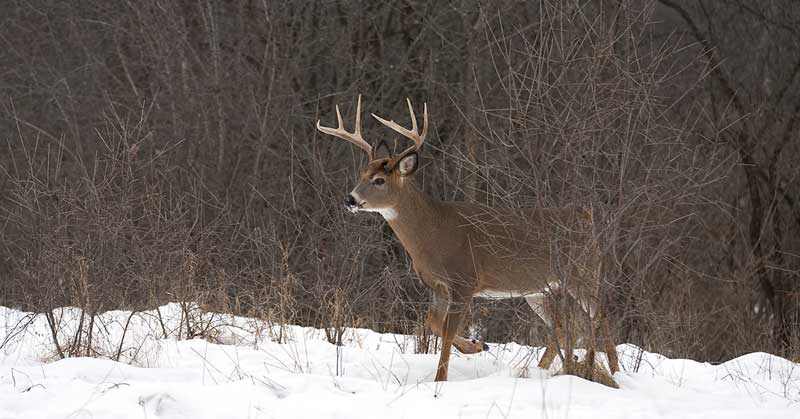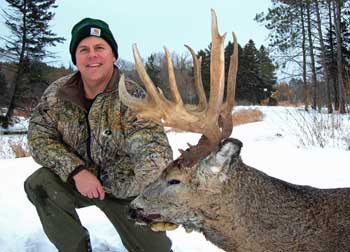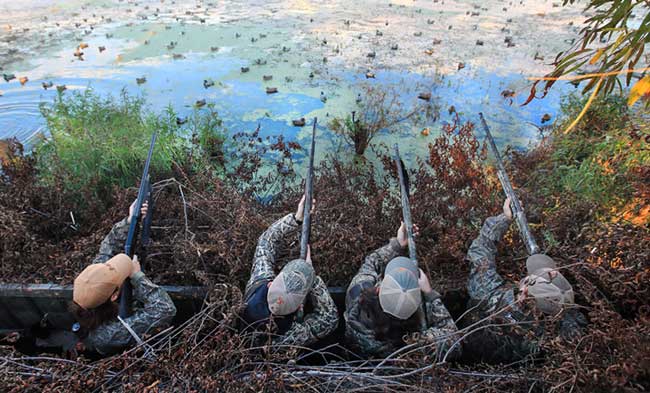by Todd Amenrud

Whitetails obviously don’t take vacations, but they do make seasonal relocations and sometimes long journeys, that is, moving into wintering grounds, often referred to as “deer yards.” These spots will have everything whitetails need to survive a nasty winter. This phenomenon is famous for happening in the deer’s northernmost range, but can also happen in the South. The moves just usually aren’t as far or as concentrated. These spots will be protected from the elements, have thermal cover, and oftentimes consist of low land where mature conifers meet areas of heavy browse. The reason they move and the areas they choose obviously offer the herd some sort of advantage.
As a young boy back in the 70s, I learned about the migration of whitetails that happened in our area from my aunt who worked with the “Cedar Creek Natural History Area” in conjunction with the University of Minnesota. Here, they conducted one of the first radio collar telemetry studies ever done in the United States. Many of the deer from my family’s 140-year-old farm left and traveled about 10 to 12 miles northeast to the Cedar Creek area (now called Cedar Creek Ecosystem Science Reserve). Back then, whitetails didn’t winter on our property - there were none around from Christmas until April. At first green-up in the spring I can remember my aunt taking me on drives along the agricultural fields surrounding the Cedar Creek Reserve and literally counting several hundred whitetails in one ag field, and there were many fields.
Even back in the 70s my family knew what it took to hold whitetails on our property, but at that time we obviously didn’t measure up. I’m incredibly lucky, because I grew up with a family that likes hunting and the outdoors. My mom’s side of the family are farmers, biologists and conservationists and my dad’s side are some of the best hunters and woodsmen I’ve ever seen. My mom’s brother was head Professor of Agriculture Economics at the University of Minnesota. (The text books that he wrote are still used to this day.) So with their help we created the habitat and conditions necessary to hold whitetails all year long. We began practicing QDM before the QDMA ever came to be. Sound principals work no matter what you label them or when you practice them.
The elements of food, water and cover have been known for many years to be the necessary rudiments of sustaining wildlife. We had whitetails for the better part of the year, so we needed to concentrate on the fundamentals specifically relating to those winter months, when we seemingly didn’t have what they needed.
The water element was covered because of snow, but back in those days, I remember there being a lot more. We also seemed to have some fair cover, so we concentrated on providing food, bolstering the wintertime cover and adding specific browse species to the flora.
Cedar swamps are notorious for making great winter deer yards. They provide protection from harsh winds and extremely important thermal cover. Thermal cover is simply shelter that captures heat from the sun. Conifer trees like cedar, red and white pine, spruce and hemlock provide excellent thermal cover because the dark green foliage absorbs the heat from the sun. Red oak trees, because they hold their brown leaves through winter, can also offer this thermal effect. With a slight circulating breeze or thermal current, it helps to distribute the radiant heat throughout the area. When riding an ATV or snowmobile into an area like this, you can dramatically feel when you enter or exit the warm air pocket.
Good wintering areas will also offer escape cover and/or security cover, where deer can flee or remain hidden from predators. In areas with wolves, I’ve seen whitetails actually move close to humans. Whitetails have learned that closer to humans means no wolves. It can also mean easier travel on snowmobile tracks or plowed trails.
A whitetail’s physiology maintains their body heat just above 100 degrees Fahrenheit all year long. While deer’s summer coat provides protection from the sun and helps keep the animal cool, the winter coat’s job is to insulate against the cold. The rough, hollow guard hairs of their winter coat provide protection and insulation, but it’s the finer, wool-like hair underneath that really affords the greatest insulation value. There aren’t as many outer guard hairs, but they are hollow, thicker and twice as long. They trap air and also create their own water repellent. Connected to each hair follicle is a small sebaceous gland that secretes an oily substance called sebum. The sebum coats the hair to help it shed water. You may have seen snow build up on a deer’s back without melting because of their coat’s excellent insulation and water repelling qualities. In addition, the deer’s winter coat is dark brown or gray and absorbs more solar energy. So their well-designed coat not only absorbs heat, it insulates against heat loss and energy expenditure.
Whitetails have the proper physiology to survive during winter, but they need food to keep that “boiler room” pumping out heat. During harsh winters, mortality can be devastating if they lack food and cover. We understood that the main element we were missing was wintertime food. Back then, our farm cash-cropped corn and alfalfa, but once the corn was harvested and the alfalfa covered in snow the bistro was bust. So my grandpa began to leave some of the cash-crop corn in several areas, but we needed more.
Since a blanket of snow usually covers the ground throughout much of the North, a food source needs to be attainable. If they can’t get to it, it doesn’t make a difference. Even before BioLogic first introduced the genetically superior brassicas from New Zealand, my dad and I learned about this plant called rape that whitetails just loved once it got cold.
Johnny Boatner, a good friend of ours, and at the time owner of “International Bowhunter” magazine, first introduced us to brassicas. Johnny had a place near Pillager, Minnesota, bordering the famed Camp Ripley. I can remember glassing from Johnny’s office and watching deer pile out of Camp Ripley into his food plots, like Walmart shoppers invading a store on Black Friday, to ravage these goofy plants that were still green despite being covered in snow. The very next year we had both corn and rape (brassicas) planted. In my view, these are the absolute two best wintertime food plot crops you can choose in areas that receive snowfall, simply because they are within reach of your deer.
Some believe that just corn will suffice. While it may sustain them, I want my herd to do better. Why not let them thrive? Not only do I try to provide everything they need to bring them into the winter in a healthy state, but they also have everything they need to sustain them through the winter and recoup from rut-related stress. Corn has terrible protein content (8-9%), but it has great carbohydrates, and that equals heat during the winter. So corn should be a part of your program, but only a part. If I had to pick one or the other I would choose brassicas. Brassicas seem to be more attractive day in and day out and there’s no comparison to the yield or nutritional stats. On average brassicas contain 36% crude protein and over 80% total digestible nutrients as well as numerous other dietary benefits. In my view, brassicas aren’t just the best wintertime food, they are the best deer food. Period.
Since then, I have discovered that it is best to have multiple varieties of brassicas, if you have enough acreage to devote. Maximum, as an example, is a blend of BioLogic’s five best brassicas. The variety offered means you have plants becoming palatable at different times so you have an attractive, nutritious food source for much longer than just a single cultivar would provide. Maximum combined with Winter Bulbs & Sugar Beets goes a long way in guiding your herd through the winter. For the past few years, on top of that, I’ve been testing Deer RADISH. These brassicas complement those two blends perfectly. Obviously, if you have limited acreage, you don’t want to go wild with too much variety. But if you have the ground to dedicate, I highly suggest all three for a perfect combination of late-season attraction and wintertime nutrition.
No matter if you have the best food plots in your state, whitetails still must have browse. Browse is the woody stems and twigs of deciduous shrubs and trees (also including several evergreens). They will normally only eat two to three inches off of the end of stem, but whitetails can put away as much as five to seven pounds of browse daily. And even though it’s not that nutritious, it seems to be necessary for them to maintain good health through the winter.
Browse and other natural food sources were something that I believed may have be missing from our area, so over the next few years I went on a tree and bush planting rampage. Some of my favorites are red osier dogwood, highbush cranberry, elderberry, white cedar, hackberry, staghorn sumac, maple and poplar. And although it can oftentimes be difficult for them to reach mast with wintertime snow depths in the north, I also planted a number of mast producing trees like apple, crabapple and several varieties of white oak.
One thing we had going for us was the variety of beautiful trees our oak savanna ridges carried. Specifically relating to the wintering capabilities of the property, I believe the red oaks helped us out considerably. Because the red oaks carry their rusty brown leaves through the winter, just like the dark conifer trees, they absorb the heat from the sun and hold it.
Although red oak acorns contain more tannins than most white oak varieties and some feel they aren’t as attractive to whitetails, they are still devoured nonetheless and they are more dependable than white oak varieties. Red oaks produce acorns more consistently than white oaks do. It’s really a combination of varieties and drop times that will be the most effective.
 A whitetail’s metabolism slows down significantly during the winter. They’ll search out these wintering areas then begin eating less and moving less. Their feeding patterns seem to rely heavily on temperature and weather patterns. I was involved in a study and collected data for several years about what makes whitetails move, and I can tell you that the temperature has a definite effect. I would estimate that movement starts to slow down when you get to around 15 degrees Fahrenheit. If you get below zero temperatures or heavy snow and wind for extended periods, you can see a herd stay bedded-up for several days.
A whitetail’s metabolism slows down significantly during the winter. They’ll search out these wintering areas then begin eating less and moving less. Their feeding patterns seem to rely heavily on temperature and weather patterns. I was involved in a study and collected data for several years about what makes whitetails move, and I can tell you that the temperature has a definite effect. I would estimate that movement starts to slow down when you get to around 15 degrees Fahrenheit. If you get below zero temperatures or heavy snow and wind for extended periods, you can see a herd stay bedded-up for several days.
It’s also said that a whitetail’s inner ear works similar to a barometer. They can sense the barometer fluctuations that typically usher in weather changes. A high steady barometer or whenever it remains stable seems to correspond with good movement, except if it’s very low. And the fast barometric movement related to weather fronts seems to also stimulate movement. Movement can be dramatic just before or just after periods of heavy snow or blizzards.
During the winter, water sources are frozen and covered by snow, but just as a dog laps the snow for moisture, so does a whitetail. Some managers may be lucky and have a spring that never freezes. In areas that have freezing temperatures but no snow and no spring, a manager needs to be conscious of providing water to their herd. Unless the ice layer gets too thick, whitetails will break through the ice for water, but I’ve also seen a manager make the rounds with a sledge hammer to break open watering holes. It all depends upon your location and temperatures.
The final two pieces of the “wintering puzzle” relate to stress. We want to eliminate all predation and give them sanctuary. Hunting and trapping their natural predators like wolves, coyotes, dogs and bobcats is a big part of keeping stress to a minimum. These are the predators that will stress them during the winter, but I would also make a push on fox and coon going into late winter and the upcoming fawning season.
Security or sanctuary is also crucial. With the slowed metabolism and the fact they take in less energy, it hurts them badly when they have to expend large amounts. So give them space and keep their stress low.
Because of continuing to add to the whitetail appeal of the property, it’s only gotten better. In fact, now we actually have numbers continually increase into the winter months. We have more deer through the winter than at any other time of the year. The reasons are simple and they’ll always be the same – food, water, cover and security.
This article is courtesy of the GameKeepers Farming for Wildlife publication, a quarterly wildlife and land management magazine produced by the Mossy Oak GameKeepers. For more information on subscribing or joining visit Mossy Oak GameKeepers Club.






























